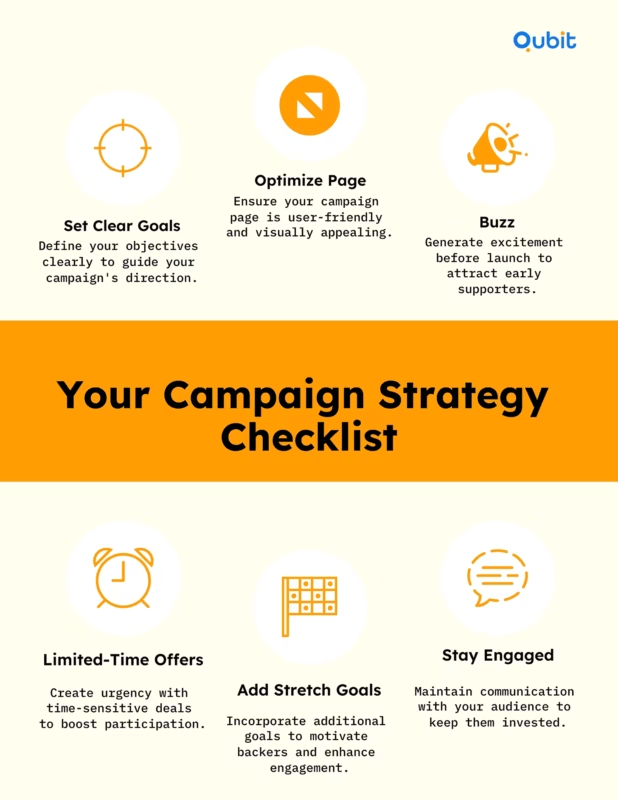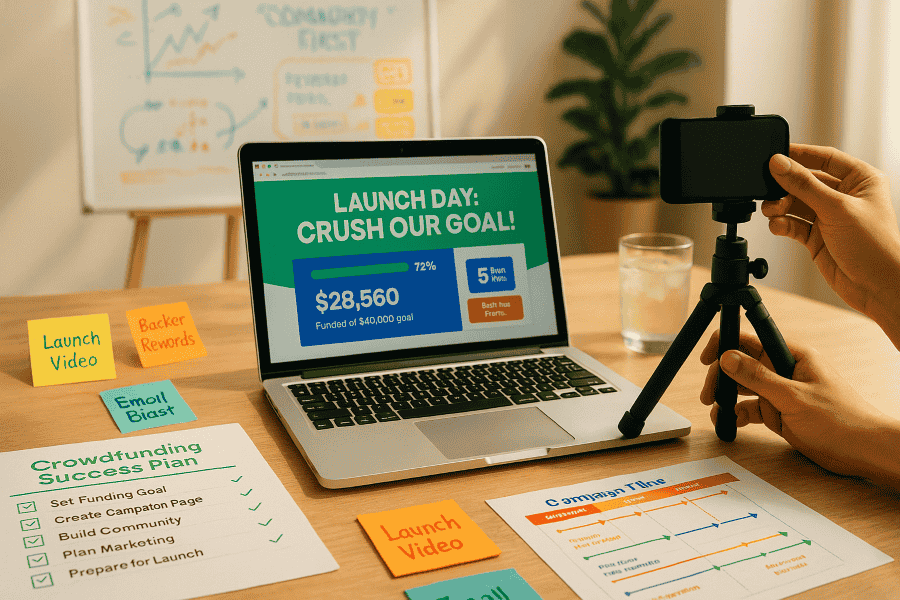Crowdfunding has emerged as an essential tool for entrepreneurs, creatives, and businesses to raise funds efficiently. But what is crowdfunding? In simple terms, it’s a method of securing capital by collecting small contributions from a large number of people, often through online platforms. From innovative startups to personal projects, this approach has transformed fundraising dynamics.
With platforms like Kickstarter paving the way, crowdfunding has proven its potential—over $34M has been raised globally, highlighting its enormous scope. However, success rates can vary, as seen on platforms like RocketHub, where data illustrates different outcomes across platforms.
Ready to dive into actionable strategies and real-world examples? Let’s jump right in!
Understanding a Crowdfunding Campaign Plan
A crowdfunding campaign plan serves as a structured roadmap to achieve financial and outreach objectives. It outlines your funding goals, target audience, and the strategies needed to connect with them effectively. Central to this plan is selecting a funding model that aligns with your project’s vision and values.
There are four primary models to consider: donations, where supporters contribute without expecting anything in return; rewards, which offer backers tangible incentives like products or experiences; equity, where contributors gain ownership stakes in your venture; and debt, involving repayment with interest. Each model serves different types of campaigns, making it crucial to assess which aligns best with your goals and audience.
Developing a clear plan not only helps clarify your financial needs but also sets the foundation for your outreach strategies. This structured approach ensures that every step—from crafting your message to engaging potential backers—is purposeful and targeted.
For those exploring alternative funding routes, comparing crowdfunding vs traditional funding provides insights into the advantages and trade-offs of each method.
Essential Elements to Excel in Your Crowdfunding Campaign
Launching a crowdfunding campaign requires more than just an idea; it demands strategy and precision. By focusing on 11 critical elements, you can significantly improve your chances of meeting—and exceeding—your funding goals.
1. Frontloading Your Campaign
Securing at least 30% of your funding goal in the first week is vital. This early momentum signals potential backers that your project is credible and worth investing in. Prioritize outreach to your network before launching to ensure immediate traction.
2. Mastering the Art of Storytelling
Compelling storytelling captures attention and builds emotional connections. Share the “why” behind your project—what inspired it, who it benefits, and how it solves a problem. A relatable and passionate narrative can transform casual visitors into committed supporters.
3. Using Professional Visuals
High-quality visuals reflect professionalism and trustworthiness. Invest in well-produced videos, attractive imagery, and engaging graphics to make your campaign visually appealing and memorable.
4. Detailed Content and Transparency
Transparency fosters trust. Provide detailed descriptions of your project, including milestones, timelines, and clear explanations of how funds will be allocated. Backers appreciate clarity and precision.
5. Reward Systems That Inspire Action
Offer creative, desirable, and attainable rewards to incentivize contributions. Rewards could range from exclusive merchandise to early access to your product, tailored to appeal to your target audience.
6. Tiered Pricing for Inclusivity
Tiered pricing ensures accessibility for diverse supporters. Create multiple reward levels so backers can contribute based on their capacity, without feeling excluded.
7. Effective Promotion
The success of your campaign partly depends on reaching the right audience. Amplify your efforts by utilizing marketing strategies for crowdfunding which play a pivotal role in attracting supporters and achieving funding goals.
8. Ongoing Communication
Keep backers updated throughout the campaign. Regular updates on progress, setbacks, and achievements maintain enthusiasm and build trust.
9. Proper Closure Planning
Once the campaign ends, celebrate your success while thanking supporters. Transition smoothly into production or development, ensuring backers remain engaged and informed.
10. Learning from Examples
Take cues from successful campaigns like Nest Houseware. Their emphasis on storytelling, professional visuals, and tiered rewards helped them achieve remarkable results.
By integrating these strategies, you’ll be better equipped to excel in your crowdfunding journey.
Quick Wins: 3 Easy Tips to Instantly Boost Your Campaign
Creating a successful crowdfunding campaign requires strategic planning and consistent effort. To secure early backers and maintain momentum, focus on three key tactics: regular updates, early outreach, and consistent brand messaging.
Kickstart your campaign by tapping into your personal network. Reach out to family, friends, and colleagues before launching publicly to build a solid foundation of initial supporters. Early outreach builds trust and encourages others to contribute once the campaign goes live.
Keep your backers engaged with frequent updates. Share milestones, behind-the-scenes content, and progress toward funding goals to maintain excitement. Clear, consistent messaging across all platforms reinforces your brand identity and strengthens your campaign’s credibility.
For inspiration and actionable lessons, explore crowdfunding success stories. These real-world examples highlight how top-funded startups turned creative ideas into thriving ventures.
12 Proven Crowdfunding Strategies You Shouldn’t Launch Without
Launching a successful crowdfunding campaign requires more than just a great idea; it demands strategic planning and execution across every stage. Below are 12 practical tips that cover pre-launch preparation, active campaign management, and post-campaign follow-up to ensure your campaign thrives.

1. Define Clear Goals
Establish specific funding targets and timelines. This clarity builds trust and motivates backers to contribute.
2. Optimize Your Campaign Page
Craft an engaging pitch with high-quality visuals and a compelling story that outlines how your project benefits supporters.
3. Build Pre-Launch Buzz
Generate excitement before launching by sharing teasers, engaging on social media, and creating an email list of potential supporters.
4. Offer Limited-Time Incentives
Create urgency with exclusive rewards for early contributors. Limited-time offers can boost initial momentum.
5. Introduce Stretch Goals
Encourage continued support by unveiling stretch goals as you near your initial target. These milestones provide fresh incentives for backers.
6. Engage Continuously
Keep backers informed through regular updates and respond promptly to inquiries. Active communication fosters loyalty.
7. Leverage Social Proof
Share testimonials and highlight media coverage to validate your campaign's credibility.
8. Use Video Content
A well-crafted campaign video can humanize your project and emotionally connect with supporters.
9. Monitor Analytics
Track campaign performance to identify trends and adjust strategies for maximum impact.
10. Collaborate with Influencers
Partnering with influencers can amplify your reach and introduce your campaign to new audiences.
11. Thank Your Backers
Express gratitude through personalized messages and public acknowledgments. Recognizing contributors builds goodwill.
12. Plan Post-Campaign Actions
After the campaign, deliver rewards promptly and maintain communication with supporters. This ensures long-term trust and sets the stage for future initiatives.
As part of your preparation, understanding Kickstarter is vital. It helps safeguard your campaign and build investor confidence.
Proper planning and continuous engagement are key to starting a crowdfunding campaign that succeeds. Apply these strategies to maximize your chances of achieving your goals!
Certainly! Please provide the specific details for the section you would like me to write, including the blog title, section title, word count, any keywords or links to integrate, and any specific data or instructions for this section.
Which Crowdfunding Platform Is Right for You? A Breakdown by Type & Goal
Crowdfunding platforms come in different forms, each tailored to unique financial goals and audience preferences. Understanding how does crowdfunding work begins with identifying the major categories.
Rewards-based platforms, such as Kickstarter, allow backers to contribute in exchange for perks or products, making them ideal for creative projects or product launches. Donation-based crowdfunding, like GoFundMe, focuses on charitable causes and community-driven campaigns, with contributors giving without expecting returns. Equity crowdfunding platforms, including SeedInvest, offer investors a stake in the business, aligning well with startups seeking significant capital. Lastly, debt crowdfunding connects borrowers and lenders, often through platforms like LendingClub, suitable for personal or business loans.
Each platform has its strengths. Rewards-based options excel in engaging audiences, while equity crowdfunding attracts serious investors. However, fees and audience expectations vary, making it crucial to evaluate which platform aligns with your campaign goals.
Understanding what is crowdfunding and choosing the right platform can significantly impact the success of your campaign.
Top Crowdfunding Platform Picks
Selecting the best crowdfunding platform can significantly impact your campaign's success. Below are some trusted platforms that have empowered countless entrepreneurs in how to start crowdfunding:
- Kickstarter: Known for creative projects, this platform is ideal for artists, designers, and innovators aiming to bring their ideas to life.
- Indiegogo: Offers flexibility, allowing creators to choose between fixed and flexible funding models.
- GoFundMe: Perfect for personal or charitable campaigns, focusing on community-driven support.
- Patreon: A subscription-based model tailored for creators seeking consistent income.
Each platform provides essential tools to optimize visibility and engagement, making it easier to reach your funding goals.
Conclusion
Planning every detail of your crowdfunding campaign is the cornerstone of success. From crafting an engaging story to creating professional visuals that captivate potential backers, each element plays a vital role. Budget management, too, is not just a task but a discipline that ensures your resources are allocated effectively.
As you implement the actionable strategies outlined in this guide, remember that storytelling is more than sharing your idea—it’s about connecting emotionally with your audience. Pair this narrative with striking visuals and transparent financial planning to build trust and enthusiasm.
If you're ready to take your campaign to the next level, we at Qubit Capital offer expert Pitch Deck Creation services to help you craft a compelling pitch. Let’s get started!
Key Takeaways
- Early frontloading of pledges within the first 24–48 hours can create momentum and social proof, significantly improving your campaign’s success rate.
- Effective storytelling combined with professional visuals is critical for capturing attention and building emotional connections with potential backers.
- A detailed and structured campaign plan — including budgeting, timelines, marketing, and fulfillment — lays a solid foundation for smooth execution.
- Regular updates and transparent communication throughout the campaign build trust, foster credibility, and keep your backer community engaged.
- Selecting the right crowdfunding platform is essential, as each caters to different types of campaigns, offers distinct tools, and attracts specific audiences that can directly impact your results.
Frequently asked Questions
How to set up a crowdfunding campaign?
To initiate a crowdfunding campaign, start by identifying your objectives and selecting a platform that aligns with your vision. Develop a compelling narrative that resonates with potential backers, emphasizing the value of your project. Early engagement with supporters and clear communication can significantly boost your campaign’s momentum.


 Back
Back



